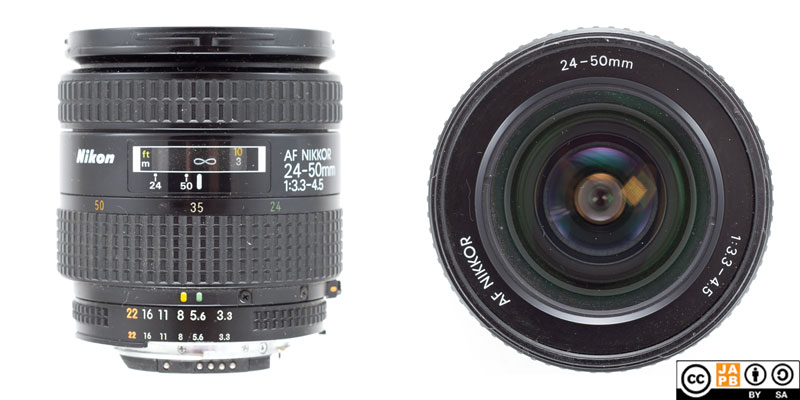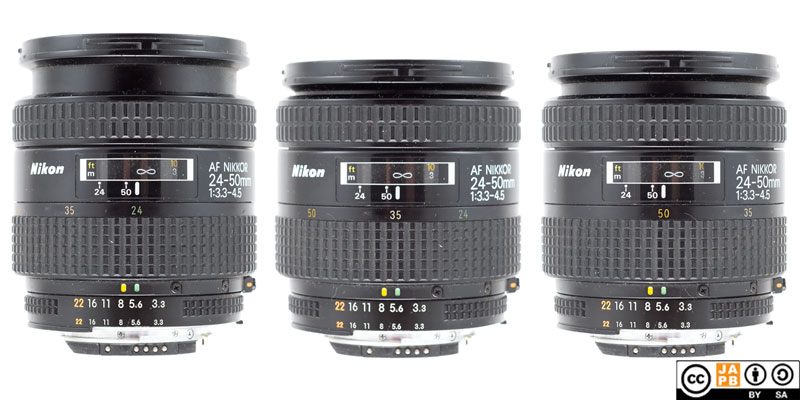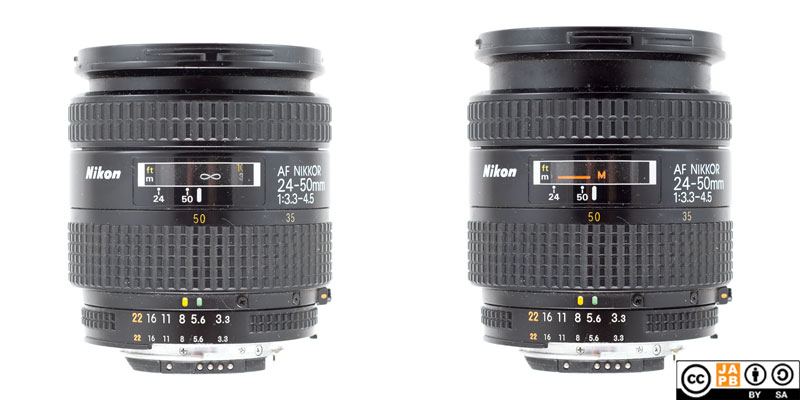Pekka Buttler, 02/2024

Specifications
The table below summarizes the lens’ key specifications (measurements based on pictured sample):
| Brand: | AF Nikkor | Lens name | 24-50mm 1:3.3–4.5 |
| Focal length(s)1 | 24–50 mm | Angle-of-view2 | 84°–46° |
| Maximum Aperture | f/3.3–4.5 | In Production | AF 1987–1995 AF-D 1995–2005 |
| Lens mount | Nikon F | Subfamily (if applicable) | AF |
| Length3 | 72,8 mm | Diameter4 | 70,4 mm |
| Filter ring diameter | 62 mm | Weight | 374 grams |
| Lens element count | 9 | Lens group count | 9 |
| Aperture blades (S/R/C)5 | 7 S | Focus throw | 110 ° |
| Minimum focusing distance | 50 cms | Maximum magnification | 1:8,5 |
| Has manual aperture ring | YES | Has Manual focus ring | YES |
Further notes:
• With its focal length range of 24–50, this lens meets the classic definition of a wide-angle zoom
• This autofocus wide-angle zoom was – at the time of its introduction in 1987 – the widest zoom in Nikon’s history, albeit by a tiny margin compared to the Ai/Ai-s 25–50/4 (1979–1985).
• Until the introduction of the Nikkor AF-D 20-35/2.8 [data sheet] in 1993, this was the only wide-angle zoom available for the Nikon AF system.
• The AF-version was manufactured from 1987 to 1995, while the AF-D version remained in production until 2005. Optically both versions are identical but the housing of the AF-D version was a bit more modern. Some ≈ 80 000 copies of the AF version were made, while ≈25 000 copies of the AF-D version were manufactured.
• This lens has a manual aperture ring. Also it is of the generation of Nikon AF lenses where autofocus was actually facilitated by a focusing motor in the camera body (not the lens).
• Nikon offered a dedicated, bayonet-mounted hood for the lens (the HB-3).
• The lens changes length while zooming (it is longer at both 24 mm and 50 mm; it is at its shortest at 35 mm).

Middle: Nikkor AF 24–50mm f/3.3–4.5 Zoomed to 35 mm
Right: Nikkor AF 24–50mm f/3.3–4.5 Zoomed to 50 mm
• The lens’ length also changes when focusing, and the filter thread and bayonet mount for the hood do rotate when focusing.

Right: Nikkor AF 24–50mm f/3.3–4.5 (@50 mm) focused to MFD
A flop or not?
As noted, when it was introduced, this lens was the only wide-angle lens on the new Nikon autofocus platform. Moreover, while you could theoretically use the older Ai/Ai-s lenses as manual focus lenses on both manual and autofocus bodies, the production of the previous generation wide-angle zooms had ended in 1985. One might therefore have expected this lens to be relatively successful.

Throughout its 18-year lifespan (1987–2005), some 85 000 copies of this lens were manufactured. Let’s put those numbers in perspective by looking at the other comparable zooms (Nikon zooms that were introduced roughly at the same time):
| Specs | Manufactured | Num years | ca. copies manufactured | ≈ copies/year |
| AF/AF-D 24-50/3.3–4.5 | 1987–2005 | 18 | 105 000 | 6 000 |
| AF 28-85/3.5–4.5 | 1986–1999 | 13 | 390 000 | 30 000 |
| AF 35–70/3.3–4.5 (the kit zoom) | 1986–1994 | 8 | 1 300 000 | 160 000 |
| AF/AF-D 35–105/3.5–4.5 | 1986–2001 | 15 | 475 000 | 30 000 |
| AF/AF-D 35–70/2.8 (a pro standard zoom) | 1987–2005 | 18 | 385 000 | 25 000 |
| AF/AF-D 80-200/2.8 ED (a pro tele zoom) | 1987–1997 | 10 | 350 000 | 35 000 |
Those who make a note of that the sales numbers of the 24-50 were weak in comparison to other contemporary zooms do have a point. The likely explanation was that the AF 24-50 offered only 4 mm more at the wide end than the AF 28-85, and that the 28-85 was a rather capable lens.
On the other hand, with those kinds of sales numbers this ‘unsuccessful’ 24-50 outsold all of its predecessors, including the 28-45/4.5 (≈ 29 000 copies), the 25-50/4 (≈ 28 000 copies) and the 28-50/3.5 (≈ 21 000 copies).
A brief genealogy of Nikon SLR lens types
Nikon is undoubtedly one of the great names in 35 mm SLR photography. The Nikon F mount has been in continuous production since 1959. During that time, the mount has developed/changed in some detail, however without ever fully sacrificing compatibility.
In short (a longer version is here), the development of Nikon’s SLR lenses can be traced as follows:
• 1959–1977: Pre-Ai. Manual focus lenses that use ‘rabbit ears’ to communicate selected aperture with the camera body.
• 1977–1986: Ai and Ai-s. Manual focus lenses that may have ‘rabbit ears’ for backward compatibility, but are designed to communicate selected aperture with the camera body through indentations in base of aperture control ring.
• 1986–today: AF and AF-D. Autofocus lenses that do not have a focusing motor within the lens, but rely on the focus motor within the camera. All AF and AF-D lenses are simultaneously Ai-s lenses (they are Ai-s lenses extended with AF) 6
• 1996–today AF-S and AF-P. Autofocus lenses that have an internal focusing motor and do not rely on the body having a focusing motor.
Adapting
Besides adapting, this lens can be used natively on all current high-end Nikon dSLRs and several earlier medium-to-high-end older Nikon dSLRs. Moreover, if the camera body contains a slot-drive focusing motor, this lens will even auto-focus7. Likewise, if the lens has been retrofitted with ‘rabbit ears’, it can be natively used on all Nikon F-mount film cameras ever produced (without the rabbit ears, it is limited to post-1977 bodies).
Thanks to being a fully manual lens (manual aperture, manual focus), the lens can be adapted to all mirrorless cameras using a suitable dumb adapter (and such adapters are easy to find). Moreover, a large range of special adapters (helicoid adapters, tilt/shift adapters, speed boosters) for using Nikon F lenses on most mirrorless systems are available. Currently no adapters for mirrorless exist that would allow autofocus through the slot-drive screw.
Using Nikon F lenses on non-Nikon SLRs and dSLRs is likewise a distinct possibility. Thanks to the relatively generous flange focal distance of the Nikon F mount (46,5 mm), adapter rings for all dSLR mounts are available as well as for a goodly portion of film-era SLR mounts. Such rings will not allow autofocus, and are unlikely to support auto aperture, but even then the lenses can be used in stop-down metering mode.
Footnotes
1 Focal length is (unless stated otherwise) given in absolute terms, and not in Full-frame equivalent. For an understanding of whether the lens is wide/tele, see ‘Angle-of-view’.
2 Picture angle is given in degrees and concerns the diagonal picture angle. Rule of thumb:
> 90 ° ==> Ultra-wide-angle
70–90 ° ==> Wide-angle
50–70 ° ==> Moderate wide-angle
40–50 ° ==> ‘Standard’ or ‘normal’ lens
20–40 ° ==> Short tele lens
10-20 ° ==> Tele lens
5-10 ° ==> Long tele lens
< 5 ° ==> Ultra-tele lens
3 Length is given from the mount flange to the front of lens at infinity.
4 Diameter excludes protrusions such as rabbit ears or stop-down levers.
5 S=straight; R=rounded; C=(almost)circular at all apertures.
6 There is a further sub-class of AF-D lenses called AF-I lenses that are otherwise AF-D lenses (meaning, fully Ai-s compatible), but have an internal focus motor. Only long tele lenses were made in AF-I variants.
7 As of this writing, the following Nikon dSLRs fully support autofocus, aperture priority and manual metered modes on Nikkor AF/AF-D lenses: D2, D3, D4, D5, D6, Df, D200, D300, D300s, D500, D600, D610, D700, D750, D780, D800, D800E, D810, D850, D7000, D7100, D7200